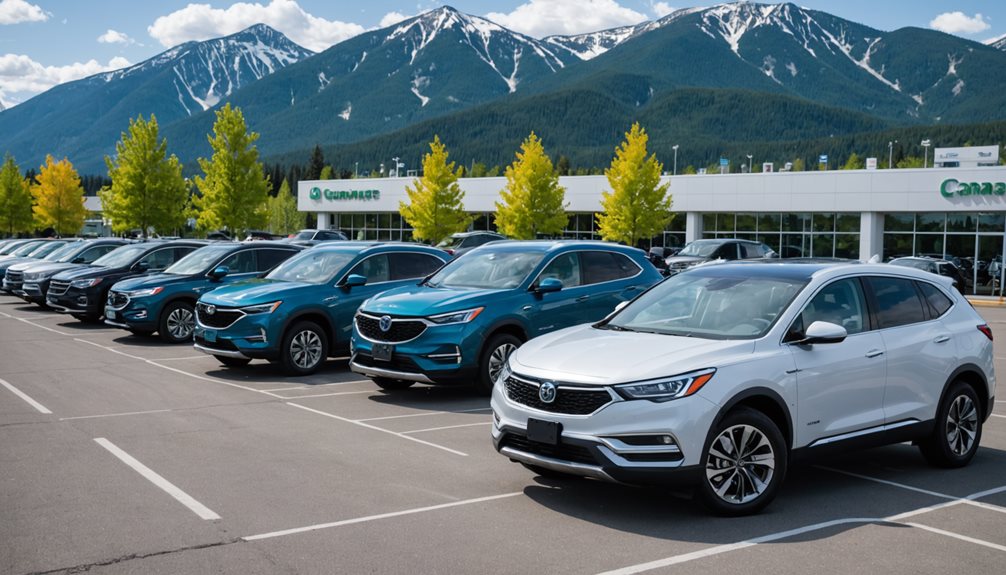If you’re searching for the best plug-in hybrid vehicles in Canada for 2026, you’ll want models offering 60–90 km electric-only range, fast Level 2 charging, and seamless shifts between electric and gas power. Top contenders deliver strong horsepower, versatile interior space, and proven battery reliability, making them perfect for both commutes and longer trips. Federal and provincial rebates further reduce upfront costs. Explore your options to see which PHEV fits your service, efficiency, and environmental priorities—there’s more to discover.
Top 8 Plug-in Hybrid Vehicles for 2026 in Canada
As Canada’s automotive landscape shifts toward greener mobility, choosing the right plug-in hybrid vehicle (PHEV) for 2026 demands careful consideration of performance, range, efficiency, and comfort.
When you’re focused on serving others—whether through carpools, community outreach, or business ventures—you need a vehicle that’s reliable, versatile, and efficient. The top eight PHEVs for 2026 in Canada stand out for their advanced battery technology, seamless integration of electric and gasoline power, and refined driving experience.
These models deliver robust horsepower, smooth progressions between power sources, and practical cabin layouts to accommodate passengers and cargo. By prioritizing models with proven battery longevity and intuitive controls, you’ll guarantee every journey is both sustainable and pleasant, supporting your commitment to environmentally responsible service.
Electric-Only Range and Charging Times Compared
How do the leading 2026 plug-in hybrid vehicles stack up when it comes to electric-only range and charging times? You’ll notice most top PHEVs now offer 60–90 km of electric-only range, making your daily commutes emission-free and efficient. When you serve others—whether it’s school drop-offs or community volunteering—this range covers most urban routes.
Charging times vary; with Level 2 chargers, expect a full battery in 2–4 hours. Fast charging isn’t standard on all models, so you’ll want to factor in your local charging infrastructure.
Battery longevity is robust, with advanced thermal management systems protecting your investment. Look for vehicles that balance quick charging and long battery life for maximum reliability while supporting your desire to drive sustainably and help others.
Government Incentives and Rebates for PHEVs in Canada
A robust selection of government incentives and rebates makes plug-in hybrid vehicles (PHEVs) more appealing for Canadian drivers looking to reduce emissions and operating costs. You’ll find federal programs like the iZEV Initiative, which offers up to $2,500 toward eligible PHEVs.
While provinces such as British Columbia and Quebec provide additional rebates. These incentives not only lower the initial purchase price but also encourage you to invest in home charging infrastructure, making daily operation more convenient.
Gas Backup Systems and Fuel Cost Savings Analysis
While fully electric vehicles rely solely on battery power, plug-in hybrid vehicles (PHEVs) distinguish themselves with integrated gas backup systems, offering valuable flexibility for Canadian drivers. You’ll find this dual capability especially helpful when serving others in rural or remote areas, where charging infrastructure may be limited.
Using a PHEV allows you to optimize your routes with fuel economy strategies—running on electricity for short trips and switching to gas for longer journeys. To maximize savings, monitor your driving habits and consider regular battery maintenance, which extends battery life and guarantees efficient performance.
Analyze your average fuel consumption and electricity usage to gauge real-world cost savings. By adopting these practices, you can deliver reliable service while reducing overall fuel expenses and environmental impact.
Frequently Asked Questions
How Do Plug-In Hybrids Perform in Extreme Canadian Winter Conditions?
You’ll find that plug-in hybrids can handle cold climate challenges, but winter driving affects their electric range and battery efficiency.
In extreme Canadian winters, batteries lose capacity more quickly, so you’ll rely on the gasoline engine more often.
Pre-conditioning your cabin while plugged in and using winter tires improve safety and comfort.
If you serve others, it’s wise to plan for reduced electric range and always monitor battery levels during severe conditions.
What Are the Maintenance Costs for PHEVS Compared to Conventional Vehicles?
You might think plug-in hybrids demand a mechanic on speed dial, but that’s an exaggeration—maintenance costs are often lower than conventional vehicles. You’ll change brake pads less frequently thanks to regenerative braking, and oil changes are less frequent.
However, watch for battery degradation, which can be expensive if it occurs out of warranty. Also, stay updated on charging infrastructure, as proper charging habits help maximize battery life and keep your vehicle running efficiently as you serve others.
Can PHEVS Tow Trailers or Heavy Loads Effectively?
You can tow trailers or moderate loads with many PHEVs, but you’ll need to verify each model’s towing capacity before planning any heavy-duty work.
PHEVs handle load management differently than traditional vehicles, relying on both electric and gasoline powertrains. Effective towing requires you to balance battery range and engine performance.
While some models offer solid towing ratings, it’s best to consult manufacturer guidelines to make sure you’re serving others safely and efficiently.
Are PHEVS Eligible for HOV Lane Access in Canadian Provinces?
High-occupancy highway hopes hinge on HOV lane policies, and you’ll find these vary across Canadian provinces. In places like Ontario and British Columbia, plug-in hybrid vehicles (PHEVs) can qualify for HOV lane access if they display the proper permits.
However, eligibility often depends on your PHEV’s electric-only range and emissions. During winter driving challenges, expect increased energy consumption, which may affect your vehicle’s compliance with certain provincial HOV lane criteria.
Always confirm current provincial regulations.
How Does Battery Lifespan Compare Between PHEVS and Fully Electric Vehicles?
You’ll find that PHEVs typically experience slower battery degradation than fully electric vehicles, mainly because they rely less on their batteries and complete fewer charging cycles. PHEVs switch to gasoline power when the battery depletes, reducing strain on the battery.
In contrast, fully electric vehicles depend entirely on their battery, increasing charging frequency and wear. To serve your community effectively, monitor battery health and encourage responsible charging habits for ideal performance and longevity.
Conclusion
When you’re considering the top 2026 PHEVs in Canada, factor in not just electric-only range and charging times, but also government incentives that can save you thousands upfront. Notably, some models now offer over 80 km of all-electric range—enough for most Canadians’ daily commutes. With gas backup systems ensuring you’re never stranded, PHEVs deliver fuel savings and reduced emissions, making them a pragmatic choice as the charging infrastructure continues to expand nationwide.
Stephen Johns is the founder of CarleaseCanada.ca A website that allows families to travel inexpensive or free. In 2014, when he was faced with an expense-intensive Lake Tahoe extended family reunion He embarked on his first adventure in the world of rewards on credit cards. The following summer, using a handful of carefully-planned credit card applications, he had used 15000 Ottawa Rapid Rewards points to pay for eight tickets to cross-country flights. He founded Points With a Crew to assist others to realize that due to rewards from credit cards your next family trip could be closer than they thought.









